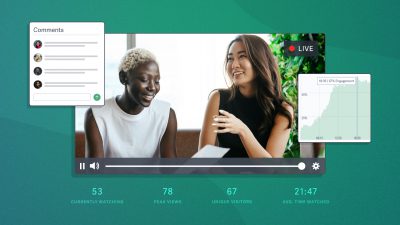Launching a live stream series is no small undertaking. There are many decisions, large and small, that need to be made before you can get it off the ground.
In this post, we’re sharing the ten key questions you need to answer before you go live.
To better understand what it takes to move in-person events online, we sat down with Emma Stones from the Garden Museum in London to get her perspective. With a wealth of experience around in-person and online events and festivals, Emma was able to talk us through how the Garden Museum found success by shifting their event series online.
Based on our conversation with Emma, as well as our own experiences with live events, we came up with the following questions that will help you succeed with online events.
1. Who is Your Audience?
It all starts with who you are trying to reach. If you’re lucky, you might have an existing audience to tap into, such as people who used to attend your events or patronize your business in person. If you’re starting more from scratch, try to do as much research as possible before getting started to build out detailed viewer personas.
The more information you have on your audience, the more likely you are to craft content they’ll want to watch. And it will inform many other decisions down the road, such as your pricing and delivery methods (more on those below).
2. Will They Actually Show Up?
This question is formulated specifically to help you put yourself in your viewers’ shoes. Why should they take time out of their busy day to attend your live stream or watch your video?
It takes more than you’d think to motivate people to take a specific action. The longer your event or video is, the greater the opportunity cost for your potential attendees.
It has to be worth their while. How will you stand out from other competing demands on their attention? Why do they have to attend your event, today?
3. How Will Your Audience Register for the Event?
Even if you already have a large following, you’ll still need to figure out how to get your attendees registered for the event. This is just as important for your audience as it is for you.
For your viewers, you can set up a registration page and workflow that sends email reminders. This will make it easy for them to add the event to their calendars, and you’ll be able to keep track of how many people will attend and capture important information, such as name and email.
Are They Willing to Pay for the Experience?
While you’re figuring out how you plan on getting folks to register, you should also consider if you plan on charging them for joining your live stream. If you’re replacing an in-person event or trying to drive new revenue with this series, charging for events might make a lot of sense. Explore this guide to learn more about paid virtual events.
4. What Kind of Audience Interaction Do You Want?
One of the best parts about creating a live stream is that it’s one of the best ways to interact with an audience outside of being in the same room with them. You’ll need to decide just how interactive you want it to be.
You just want to deliver a message in real time, or maybe you’ll want direct feedback and discussion. The latter would require additional software like live chat or a commenting feature for your guests to leave comments or questions.
Depending on your format, you may need additional team members available to field questions, moderate, or pass questions on to your speaker to respond in real time.
5. What Kind of Equipment Do You Need?
Equipment is going to be an important part of your live stream setup. It can range from the bare minimum like a webcam and microphone, all the way to top-of-the-line video production equipment.
A professional setup will take your production value to a whole new level. This type of setup might include lights, cameras, tripods, microphones, and more. For a full run-down on the equipment you may need, explore our “How to Film Yourself for a Professional Result” post.
6. How Are You Streaming it to Your Audience?
There are a ton of ways you can reach your audience with live video nowadays. Deciding on which avenue to go down will vary depending on the type of content you are trying to present to your audience.
Are you trying to reach a broad audience? Hosting live events through social media may be the way to go. This is best if you already have a large audience on one of the many social platforms that offer live streaming.
Do you want complete control over your production? Opting for a professional video hosting service might be the right move. Professional services give you more control over your brand presentation, and give you access to privacy settings and video marketing tools like lead capture or calls to action. Some software also allows you to multi-cast your event to social media platforms, making it the best of both worlds.
Are you planning for a ton of audience interaction? Trying a video conferencing application may work best. This is great when you have multiple speakers, panel discussions, or need direct audience interaction.
7. Who Are the Hosts?
All the planning in the world is great, but you’ll need someone who can actually present the information. Hosting can look easy, but it actually can be a lot of work. You’ll need someone comfortable on camera, good at asking questions, and quick on their feet if anything goes wrong.
Typically this may fall on the shoulders of someone in your marketing department but be sure to ask around your office and assess people’s willingness to being on camera. Once you pick a host, be sure to run through these 27 tips with them to help them appear more natural on camera.
8. How Will You Keep it Interesting?
Beyond having great information to share and a captivating host, consider adding additional elements. This could be video segments, photos, statistics, screen captures, and more. Ask yourself what sort of additional elements will help you convey your message even more effectively.
9. What Happens After the Event?
You just absolutely crushed your event. Now what? This is an important question to consider since your audience is probably thinking the same thing.
Are you sending a follow-up email? Do you have additional material for attendees to look into directly afterward? Do you have a call to action for attendees? Will there be a recording of the event available for those who couldn’t make it live? Great follow-up will help keep your audience coming back for future episodes.
10. What Metrics Will You Track?
When it’s all said and done, you’ll most definitely want to take a look at how each event performed. Tracking metrics during and after each broadcast will allow you to better understand how you’re performing overall.
You should look at metrics like: watch time, peak views, average minutes watched, location, and more. The more information you can acquire from your viewers’ watch habits, the better decisions you can make moving forward.
Asking yourself these 10 questions will set you up for success when planning a compelling live-stream series. Hammering out the details, growing an audience, and hitting your stride while going live may take some time, but it will be worth it. In the comments below, let us know what types of live events you have planned for the future.








